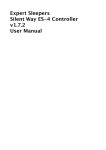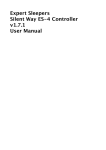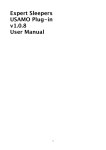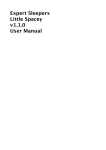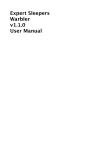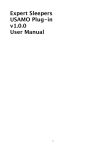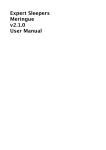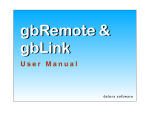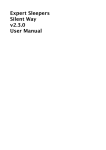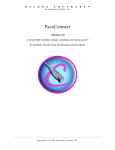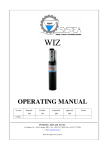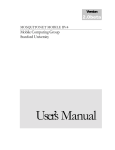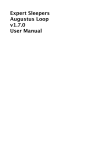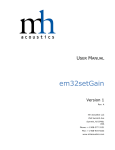Download Expert Sleepers Silent Way ES-4 Controller v1.7.0beta User Manual
Transcript
Expert Sleepers Silent Way ES-4 Controller v1.7.0beta User Manual BETA Release This is a beta release and will expire at the end of December 2011. A new release will be provided on the Expert Sleepers website before that date. Copyright © 2011 Expert Sleepers. All rights reserved. This manual, as well as the software described in it, is furnished under licence and may be used or copied only in accordance with the terms of such licence. The content of this manual is furnished for informational use only, is subject to change without notice, and should not be construed as a commitment by Expert Sleepers. Expert Sleepers assumes no responsibility or liability for any errors or inaccuracies that may appear in this document. THE SOFTWARE IS PROVIDED "AS IS", WITHOUT WARRANTY OF ANY KIND, EXPRESS OR IMPLIED, INCLUDING BUT NOT LIMITED TO THE WARRANTIES OF MERCHANTABILITY, FITNESS FOR A PARTICULAR PURPOSE AND NONINFRINGEMENT. IN NO EVENT SHALL THE AUTHORS OR COPYRIGHT HOLDERS BE LIABLE FOR ANY CLAIM, DAMAGES OR OTHER LIABILITY, WHETHER IN AN ACTION OF CONTRACT, TORT OR OTHERWISE, ARISING FROM, OUT OF OR IN CONNECTION WITH THE SOFTWARE OR THE USE OR OTHER DEALINGS IN THE SOFTWARE. Contents Introduction 6 Current Limitations 7 A note on MIDI channels 7 Gate Expander outputs 7 Plug-in variants 7 Installation 8 Mac OS X, Audio Unit (AU)! Mac OS X, VST! Windows (VST)! 8 8 8 System Requirements 8 Mac OS X! Windows! 8 8 Using Silent Way 9 Using the controls 9 Knobs! Dropdown menus! Value edit boxes! Name/value display! 9 9 9 9 The ES-4 Controller Controls 10 MIDI/CV 1/2 10 Channel! Min & Max! Gate! Vel! Priority! 10 10 10 10 10 Outputs 11 Gates 11 Triggers 11 MIDI Out 12 Channel! Channelise! Output! Clock! Swing! Offset! 12 12 12 12 12 13 Misc 13 Output Indicators 13 Inputs 13 Thru! 1-5! 13 14 Input Modes Preferences 14 15 OSC Base Port! Eye candy! Constant redraw! Floating tooltip! 15 15 15 15 OSC Control 16 Reference MIDI & OSC Scripting 16 16 Reference 16 Script locations 16 Version History 17 Contact 18 Acknowledgements 19 Lua 19 oscpack 19 glew 20 FreeType 21 FTGL 21 libpng 21 zlib 21 Introduction The Silent Way ES-4 Controller plug-in is a special element of the Silent Way plug-in suite, dedicated to controlling the Expert Sleepers ES-4 module. Unlike the rest of the Silent Way plug-ins, the ES-4 Controller does not time out, allowing unrestricted use without a Silent Way licence. However, some advanced features of the ES-4 Controller are only available to owners of a active licence. The ES-4 Controller offers: • • • • • Two MIDI/CV channels, offering the features of a standard MIDI/CV converter, driving the ES-4’s two pitch outputs (1 & 2). Controls that directly set the exact output signal of the ES-4’s five channels. MIDI note on/off control over the 40 possible gate outputs. A MIDI out generator, allowing an ES-4 Gate Expander output to be used as a MIDI output, transmitting all the usual MIDI messages, including MIDI clock. Inputs for routing generic CV sources (e.g. other Silent Way plug-ins) or audio to the ES-4’s outputs (requires a Silent Way licence). Current Limitations The current release of the ES-4 Controller is an early version of the software, released to support the first customers of the ES-4 modules. It is anticipated that the software will mature quickly in response to customer feedback. Also, there are a number of features that are definitely required that have not yet been implemented: • • • • The MIDI/CV channels need a trigger output, as well as a gate output. The MIDI/CV channels don’t have a generic MIDI CC response (e.g. for mod wheel), though you can achieve the same thing by using the DAW’s MIDI parameter control to drive the direct output controls. There is currently no pitchbend support. While the plug-in has now been integrated with the rest of the Silent Way suite, giving access to the powerful Silent Way LFO, we may build LFOs and envelopes into the ES-4 Controller itself. A note on MIDI channels The ES-4 Controller packs a lot of functionality into one plug-in, and to address all of that functionality via MIDI, the various blocks of the plug-in let you choose which MIDI channel they respond to. However, not all DAWs pass MIDI to plug-ins on multiple MIDI channels. Ableton Live, for example, always passes MIDI to plug-ins on channel 1, no matter what the MIDI channel of the messages arriving into Live itself. The exact implications of this will vary from DAW to DAW, but it’s worth bearing in mind, if things don’t appear to be working as you expect. Gate Expander outputs A number of the plug-in’s controls let you choose ES-4 Gate Expander outputs. These are listed as a pair of numbers e.g. “1/6” is gate 6 on the Gate Expander connected to the ES4‘s channel 1; “5/2” is gate 2 on the Gate Expander connected to the ES-4’s channel 5. Plug-in variants The ES-4 controller is supplied in both ‘instrument’ and ‘effect’ variants. These are identical; they simply appear in different places in your DAW’s plug-in lists, and are provided to allow maximum flexibility in how you use the plug-in. Installation Mac OS X, Audio Unit (AU) The plug-in files have the extension “.component”. Simply copy the files to the folder: Library/Audio/Plug-Ins/Components Mac OS X, VST The plug-in files have the extension “.vst”. Simply copy the files to the folder: Library/Audio/Plug-Ins/VST Windows (VST) The plug-in files have the extension “.dll”. Simply copy the files to your VST plug-ins folder. System Requirements Mac OS X Silent Way requires at least Mac OS X version 10.4.11. The plug-ins are Universal Binaries and so will work on PowerPC or Intel Macs. The Audio Unit versions will work in any Audio Unit host. The VST versions require a “VST 2.4” compatible host.1 Windows Silent Way has been developed and tested with Windows XP SP2 and Windows 7. It may work with other versions of Windows (Vista included) but this is by no means guaranteed. The plug-ins require a “VST 2.4” compatible host. 1 VST is a trademark of Steinberg Media Technologies GmbH. Using Silent Way Using the controls Knobs Basic use of the knobs is to click on them and drag the mouse up and down. However you can obtain different results by holding keys as follows: • • • Shift : Values change more slowly as you move the mouse. Command1 (Mac OS X)/Alt (Windows) : The knob assumes its default position. Option 2 (Mac OS X)/Control (Windows): The knob assumes integer values only. Dropdown menus Clicking on the menu displays the list of options. Move the mouse over the desired option and release the mouse to select it. Value edit boxes These boxes (below each knob and slider) let you enter parameter values directly. Clicking on the value highlights it in green - you can then type the desired value using the keyboard. Press enter to finish and accept the new value. While you’re typing the value, the box goes red to indicate that the value you see has not yet been accepted. Name/value display As you move the mouse around the interface, the name and current value of the control currently under the mouse is displayed in the top right of the window. This area also provides tool-tips for buttons. 1 The ‘Command’ key is also known as the ‘Apple’ key - the one next to the spacebar. 2 The ‘Option’ (alt) key is the one between the Control (ctrl) key and the Command (cmd) key. The ES-4 Controller Controls MIDI/CV 1/2 These two groups of controls provide functionality similar to that of a traditional standalone MIDI/CV converter, for each of the ES4’s pitch CV outputs (outputs 1 & 2). Channel Specifies the MIDI channel that the converter responds to, or ‘Off’ to disable the converter completely. Min & Max Specify the range of MIDI notes that the converter responds to. This lets you set up a keyboard split, using the two converters on the same MIDI channel. Gate Specifies the ES-4 output to use for the gate signal (an on/off CV signal reflecting whether a note is held or not). You can choose any of the ES-4’s 5 outputs, or one of the 40 possible Gate Expander outputs. Setting this to ‘Off’ disables the gate signal. Vel Specifies the ES-4 output to use for the velocity signal (a CV reflecting the velocity of the MIDI note being played). You can choose any of the ES-4’s 5 outputs. Setting this to ‘Off’ disables the velocity signal. Priority Sets the note priority mode. Since the ES-4 Controller behaves as a monophonic synth, a scheme is required to determine which note sounds when multiple keys are held at the same time. The options are: • • • Newest - the most recently pressed key sounds. Lowest - the lowest note sounds. Highest - the highest note sounds. Outputs These controls let you directly set the output levels of the ES-4’s 5 outputs. The values range from 0 to 255 (an 8 bit value). These can be particularly useful when combined with MIDI controller mapping in your DAW to, say, map a synth mod wheel to a CV output for filter cutoff. Via OSC or MIDI, you have the possibility to control the ES-4 and/or the Gate Expanders down to the individual bit (i.e. gate). Gates This section offers MIDI note on/off control over the 40 gate outputs from the ES-4 Gate Expanders. There is a pair of controls for each of the ES-4’s 5 channels i.e. the 5 possible Gate Expanders. “Channel” sets the MIDI channel to respond to, or “Off”. “Base” sets the base note to respond to, which will control the Gate Expander’s output 1. The remaining 7 outputs will be controlled by the 7 MIDI notes above the base note e.g. if the base note is 48, outputs 1 to 8 on the Gate Expander will be controlled by notes 48 to 55. Triggers The ‘Triggers’ button exposes a new section of controls, which allow each of the 40 possible gate outputs above to be used as a trigger instead i.e. a short pulse is emitted at each MIDI note on, and note offs are ignored. Each trigger length control sets the trigger time, in milliseconds, or ‘Off’ to allow normal gate functionality. MIDI Out This section allows a Gate Expander output to be used as a MIDI output. Because the ES4’s outputs are derived from an audio signal, the MIDI messages sent from an ES-4 are free from the timing problems often associated with regular (e.g. USB) MIDI interfaces. Note: The MIDI out feature is available when the input sample rate is 48kHz or above. In particular, it may not work reliably at 44.1kHz, though some users have reported success at this sample rate with certain hardware. Channel Specifies the MIDI channel to receive on. All MIDI messages from this channel are echoed out to the ES-4’s output. “Off” disables this feature (but not the MIDI clock output, if enabled). “Omni” receives messages on all MIDI channels. Channelise If set to “Off”, MIDI messages are sent out on the same channel on which they are received. If set to a channel number (1-16), the incoming MIDI messages are sent out on the specified channel. Output Selects the Gate Expander output that will carry the MIDI signal. Clock If enabled, causes the plug-in to send MIDI timing clock messages, synced to the DAW’s transport. When Clock is enabled, MIDI clock is generated when the host DAW’s transport is running. The MIDI clock generation always begins at the start of a bar; if the host transport is started in the middle of a bar, the plug-in waits for the next bar before starting the MIDI clock. Swing These controls allow you to add ‘shuffle’ or ‘swing’ timing to the clock output. Swing has two controls. The knob sets the amount of swing, in percent. 50% means no swing (the middle sixteenth note is 50% of the way between the neighbouring notes, as normal). Higher values of swing make the middle note later; lower values make it earlier. At 100%, the middle note is right on top of the following note. The dropdown menu chooses between sixteenth and eighth note swing. Offset The Offset control applies a small delay or advance in the timing of the MIDI clock, relative to the host’s transport. This can be used to compensate for any difference in the response time of the hardware being synced. Misc The “Test” control causes the plug-in to emit various diagnostic signals. Users should not need to worry about this in normal use. Output Indicators The row of numbers just above the ‘Prefs’ button show the values currently being output on the 5 ES-4 output channels. Inputs This section controls the routing of other signals into the plug-in and on to the ES4. The plug-in has 8 inputs, organised as 4 stereo pairs. Quite how this is handled by the DAW will vary considerably from DAW to DAW. Some DAWs are very flexible (e.g. Ableton Live) while some make it very hard to route audio into such a plug-in (e.g. Logic Pro). If your DAW of choice is lacking in this regard, we recommend the use of Plogue Bidule, which provides a very flexible and modular plug-in environment, and can itself be used as a plug-in within the DAW. Each menu in this section lets you choose from the available input channels, or set the connection to ‘Off’. Thru The ‘Thru’ input connection is designed to allow multiple ES-4 Controllers to be ‘stacked’, their outputs being combined in a logical manner. By default the Thru connection is taken from the first stereo pair of inputs, which is what will be connected if you simply insert a sequence of ES-4 Controller plug-ins on the same track in your DAW. This is how you would, for example, use multiple ES-4 Controllers to generate multiple streams of output MIDI (using the MIDI Out section, above). This is also useful when you want to use the two MIDI/CV outputs on separate MIDI channels and the DAW doesn’t provide a way to send two MIDI channels to one ES-4 Controller. Stack two instances of the plug-in, use MIDI/CV 1 on one instance and MIDI/CV 2 on the other, and then send your two MIDI streams to the two plug-ins. 1-5 Note: the use of inputs 1-5 requires a full Silent Way licence. Without a licence, the inputs will work for 15 minutes and then time out. These inputs simply route audio (or CVs) from the selected plug-in input to the relevant ES-4 output. This is how you would, for example, use the Silent Way LFO plug-in to send LFO signals out of the ES-4. Input Modes These menus work in conjunction with the input 1-5 options above, and define how the incoming audio/ CV stream is mapped onto the ES-4’s output range. ‘Unipolar’ means that positive inputs from 0.0 to 1.0 will be mapped to the ES-4’s output range (0 to 255). Negative inputs will be clamped at zero. ‘Bipolar’ means that inputs from -1.0 to 1.0 will be mapped to the ES-4’s output range, with 0.0 being mapped to a mid-scale output on the ES-4 (128). To some extent these settings will want to match the ES-4’s jumper settings, but this is by no means a necessity. For sending audio to the ES-4, it is recommended to use an input set to Bipolar, and with an ES-4 channel with the jumper in the bipolar (±5V) setting. For CVs, use whatever works well for you. Preferences Pressing the ‘Prefs’ button brings up a dialog where various preferences are set. These settings are shared by all instances of Silent Way, and are not stored with presets. The top section shows the product version. The central section will show your serial number once you’ve bought a registration. OSC Base Port Sets the base port number for OSC. See the section on OSC, below. Eye candy Enables the pretty graphics. Turn off if you don’t like them, or if your computer has compatibility issues with drawing such things. Constant redraw Is on by default. If turned off, the GUI is only redrawn when a control changes. Use this if you’re concerned that the GUI is wasting your CPU resources. Floating tooltip Causes the parameter name and value display (usually in the top right of the GUI) to be displayed above the mouse pointer. OSC Control Silent Way plug-ins can be controlled via the Open Sound Control (OSC) protocol. If you’re new to OSC, start by visiting opensoundcontrol.org. Two settings control what port the plug-in uses to listen on for OSC commands. One is the base OSC port, set in the preferences. The second is the OSC Port Offset control. If the port offset is set to something other than ‘Off’, then the two numbers are added together and the result used as the port number. E.g. if the base port is 6000 and the port offset is 1, then the plug-in will listen on port 6001. Reference All Expert Sleepers plug-ins that support OSC share a common implementation. This is documented in the ‘OSC Control Manual’, available from the Expert Sleepers website. MIDI & OSC Scripting It is possible to extend the plug-in’s MIDI & OSC functionality via user-writeable scripts. Indeed, the standard MIDI functionality described above has been re-implemented using such a script, which you can use as reference for your customisations. The language used for the MIDI scripts is Lua. You will find a complete description of the language, and some useful tutorials, at the Lua website: www.lua.org All the standard language features of Lua are available in the scripts, plus some extra functions specific to the Expert Sleepers system. Reference All Expert Sleepers plug-ins that support MIDI/OSC scripting share a common implementation. This is documented in a the ‘MIDI & OSC Scripting Manual’, available from the Expert Sleepers website. Script locations The plug-in name for constructing the script locations is Silent Way ES-4 Controller Version History 1.7.0 24/11/11 • • • Fixed the plug-in’s response to MIDI channels (previously it would respond to messages on any and all MIDI channels) and added a ‘Channelise’ capability to the MIDI Out section. Removed the DIN sync generator, which is now available (and extended) in the separate Silent Way Sync plug-in. Fixed various issues with parameter automation and GUI updates. 1.6.14 31/10/11 • Added Trigger Length controls. 1.6.12 18/10/11 • • MIDI clock and DIN sync reimplemented. Added Offset control to MIDI clock and DIN sync. 1.6.11 5/10/11 • Slight tweak to the input calculation, to match the Silent Way Voice Controller and Silent Way Quantizer’s ES-4 modes. 1.6.9 15/9/11 • • • Added inputs. Plug-in now exists in effect and instrument variations. Corrected VST plug-in name. 1.6.8 2/9/2011 • ! First release. Contact The Expert Sleepers website is here: http://www.expert-sleepers.co.uk/ Or you can email [email protected] Or you can use the Expert Sleepers forum, which is here: http://www.kvraudio.com/forum/viewforum.php?f=85 Or you can use the dedicated Silent Way forum, which is here: http://www.muffwiggler.com/forum/viewforum.php?f=35 Acknowledgements The software described in this manual makes use of the following open source projects. The author is greatly indebted to them for their efforts and generosity. Below are reproduced the various copyright notices and disclaimers that accompany these software projects, in accordance with their terms of use. Lua Copyright (C) 1994-2008 Lua.org, PUC-Rio. Permission is hereby granted, free of charge, to any person obtaining a copy of this software and associated documentation files (the "Software"), to deal in the Software without restriction, including without limitation the rights to use, copy, modify, merge, publish, distribute, sublicense, and/or sell copies of the Software, and to permit persons to whom the Software is furnished to do so, subject to the following conditions: The above copyright notice and this permission notice shall be included in all copies or substantial portions of the Software. THE SOFTWARE IS PROVIDED "AS IS", WITHOUT WARRANTY OF ANY KIND, EXPRESS OR IMPLIED, INCLUDING BUT NOT LIMITED TO THE WARRANTIES OF MERCHANTABILITY, FITNESS FOR A PARTICULAR PURPOSE AND NONINFRINGEMENT. IN NO EVENT SHALL THE AUTHORS OR COPYRIGHT HOLDERS BE LIABLE FOR ANY CLAIM, DAMAGES OR OTHER LIABILITY, WHETHER IN AN ACTION OF CONTRACT, TORT OR OTHERWISE, ARISING FROM, OUT OF OR IN CONNECTION WITH THE SOFTWARE OR THE USE OR OTHER DEALINGS IN THE SOFTWARE. oscpack oscpack -- Open Sound Control packet manipulation library http://www.audiomulch.com/~rossb/code/oscpack Copyright (c) 2004 Ross Bencina <[email protected]> Permission is hereby granted, free of charge, to any person obtaining a copy of this software and associated documentation files (the "Software"), to deal in the Software without restriction, including without limitation the rights to use, copy, modify, merge, publish, distribute, sublicense, and/or sell copies of the Software, and to permit persons to whom the Software is furnished to do so, subject to the following conditions: The above copyright notice and this permission notice shall be included in all copies or substantial portions of the Software. Any person wishing to distribute modifications to the Software is requested to send the modifications to the original developer so that they can be incorporated into the canonical version. THE SOFTWARE IS PROVIDED "AS IS", WITHOUT WARRANTY OF ANY KIND, EXPRESS OR IMPLIED, INCLUDING BUT NOT LIMITED TO THE WARRANTIES OF MERCHANTABILITY, FITNESS FOR A PARTICULAR PURPOSE AND NONINFRINGEMENT. IN NO EVENT SHALL THE AUTHORS OR COPYRIGHT HOLDERS BE LIABLE FOR ANY CLAIM, DAMAGES OR OTHER LIABILITY, WHETHER IN AN ACTION OF CONTRACT, TORT OR OTHERWISE, ARISING FROM, OUT OF OR IN CONNECTION WITH THE SOFTWARE OR THE USE OR OTHER DEALINGS IN THE SOFTWARE. glew The OpenGL Extension Wrangler Library Copyright (C) 2002-2007, Milan Ikits <milan ikits[]ieee org> Copyright (C) 2002-2007, Marcelo E. Magallon <mmagallo[]debian org> Copyright (C) 2002, Lev Povalahev All rights reserved. Redistribution and use in source and binary forms, with or without modification, are permitted provided that the following conditions are met: * Redistributions of source code must retain the above copyright notice, this list of conditions and the following disclaimer. * Redistributions in binary form must reproduce the above copyright notice, this list of conditions and the following disclaimer in the documentation and/or other materials provided with the distribution. * The name of the author may be used to endorse or promote products derived from this software without specific prior written permission. THIS SOFTWARE IS PROVIDED BY THE COPYRIGHT HOLDERS AND CONTRIBUTORS "AS IS" AND ANY EXPRESS OR IMPLIED WARRANTIES, INCLUDING, BUT NOT LIMITED TO, THE IMPLIED WARRANTIES OF MERCHANTABILITY AND FITNESS FOR A PARTICULAR PURPOSE ARE DISCLAIMED. IN NO EVENT SHALL THE COPYRIGHT OWNER OR CONTRIBUTORS BE LIABLE FOR ANY DIRECT, INDIRECT, INCIDENTAL, SPECIAL, EXEMPLARY, OR CONSEQUENTIAL DAMAGES (INCLUDING, BUT NOT LIMITED TO, PROCUREMENT OF SUBSTITUTE GOODS OR SERVICES; LOSS OF USE, DATA, OR PROFITS; OR BUSINESS INTERRUPTION) HOWEVER CAUSED AND ON ANY THEORY OF LIABILITY, WHETHER IN CONTRACT, STRICT LIABILITY, OR TORT (INCLUDING NEGLIGENCE OR OTHERWISE) ARISING IN ANY WAY OUT OF THE USE OF THIS SOFTWARE, EVEN IF ADVISED OF THE POSSIBILITY OF SUCH DAMAGE. Mesa 3-D graphics library Version: 7.0 Copyright (C) 1999-2007 Brian Paul All Rights Reserved. Permission is hereby granted, free of charge, to any person obtaining a copy of this software and associated documentation files (the "Software"), to deal in the Software without restriction, including without limitation the rights to use, copy, modify, merge, publish, distribute, sublicense, and/or sell copies of the Software, and to permit persons to whom the Software is furnished to do so, subject to the following conditions: The above copyright notice and this permission notice shall be included in all copies or substantial portions of the Software. THE SOFTWARE IS PROVIDED "AS IS", WITHOUT WARRANTY OF ANY KIND, EXPRESS OR IMPLIED, INCLUDING BUT NOT LIMITED TO THE WARRANTIES OF MERCHANTABILITY, FITNESS FOR A PARTICULAR PURPOSE AND NONINFRINGEMENT. IN NO EVENT SHALL BRIAN PAUL BE LIABLE FOR ANY CLAIM, DAMAGES OR OTHER LIABILITY, WHETHER IN AN ACTION OF CONTRACT, TORT OR OTHERWISE, ARISING FROM, OUT OF OR IN CONNECTION WITH THE SOFTWARE OR THE USE OR OTHER DEALINGS IN THE SOFTWARE. Copyright (c) 2007 The Khronos Group Inc. Permission is hereby granted, free of charge, to any person obtaining a copy of this software and/or associated documentation files (the "Materials"), to deal in the Materials without restriction, including without limitation the rights to use, copy, modify, merge, publish, distribute, sublicense, and/or sell copies of the Materials, and to permit persons to whom the Materials are furnished to do so, subject to the following conditions: The above copyright notice and this permission notice shall be included in all copies or substantial portions of the Materials. THE MATERIALS ARE PROVIDED "AS IS", WITHOUT WARRANTY OF ANY KIND, EXPRESS OR IMPLIED, INCLUDING BUT NOT LIMITED TO THE WARRANTIES OF MERCHANTABILITY, FITNESS FOR A PARTICULAR PURPOSE AND NONINFRINGEMENT. IN NO EVENT SHALL THE AUTHORS OR COPYRIGHT HOLDERS BE LIABLE FOR ANY CLAIM, DAMAGES OR OTHER LIABILITY, WHETHER IN AN ACTION OF CONTRACT, TORT OR OTHERWISE, ARISING FROM, OUT OF OR IN CONNECTION WITH THE MATERIALS OR THE USE OR OTHER DEALINGS IN THE MATERIALS. FreeType The FreeType Project is copyright (C) 1996-2000 by David Turner, Robert Wilhelm, and Werner Lemberg. THE FREETYPE PROJECT IS PROVIDED `AS IS' WITHOUT WARRANTY OF ANY KIND, EITHER EXPRESS OR IMPLIED, INCLUDING, BUT NOT LIMITED TO, WARRANTIES OF MERCHANTABILITY AND FITNESS FOR A PARTICULAR PURPOSE. IN NO EVENT WILL ANY OF THE AUTHORS OR COPYRIGHT HOLDERS BE LIABLE FOR ANY DAMAGES CAUSED BY THE USE OR THE INABILITY TO USE, OF THE FREETYPE PROJECT. FTGL Copyright (C) 2001-3 Henry Maddocks Permission is hereby granted, free of charge, to any person obtaining a copy of this software and associated documentation files (the "Software"), to deal in the Software without restriction, including without limitation the rights to use, copy, modify, merge, publish, distribute, sublicense, and/or sell copies of the Software, and to permit persons to whom the Software is furnished to do so, subject to the following conditions: The above copyright notice and this permission notice shall be included in all copies or substantial portions of the Software. THE SOFTWARE IS PROVIDED "AS IS", WITHOUT WARRANTY OF ANY KIND, EXPRESS OR IMPLIED, INCLUDING BUT NOT LIMITED TO THE WARRANTIES OF MERCHANTABILITY, FITNESS FOR A PARTICULAR PURPOSE AND NONINFRINGEMENT. IN NO EVENT SHALL THE AUTHORS OR COPYRIGHT HOLDERS BE LIABLE FOR ANY CLAIM, DAMAGES OR OTHER LIABILITY, WHETHER IN AN ACTION OF CONTRACT, TORT OR OTHERWISE, ARISING FROM, OUT OF OR IN CONNECTION WITH THE SOFTWARE OR THE USE OR OTHER DEALINGS IN THE SOFTWARE. libpng http://www.libpng.org/pub/png/libpng.html zlib http://www.zlib.net/





















